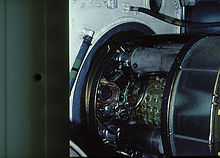Bristol Proteus

The Bristol Proteus was a shaft turbine made by the British manufacturer Bristol for aviation purposes. It was a twin-shaft engine in which one turbine only supplied the shaft power and the other drove the compressor. The combustion air was sucked in over the entire circumference of the rear part of the engine and compressed by a twelve-stage axial compressor towards the front part. There the gas flow was diverted by 180 degrees and fed to the eight combustion chambers made from Nimonic . From there, the gas flowed through individual ducts led through the intake area to the two two-stage turbine sets, from where it exited through a non-adjustable thrust nozzle. This was made of austenitic steel and had a central cone. The production versions from Mk. 700 onwards also received a radial stage made of steel behind the axial compressor.
The speed of the power turbine was reduced by a planetary gear in a ratio of 11.11: 1. The engine was supplied with fuel by a pressure pump at a maximum pressure of 98.4 kg / cm². This included a barometric quantity correction and the actual thrust control valve. The fuel was ignited electrically, for which purpose spark plugs were installed in two combustion chambers. An electric starter brought the engine to the necessary starting speed. The lubrication was carried out as dry sump lubrication .
In May 1946, the Bristol Phoebus , as the predecessor of the Proteus, was put to the test for the first time. The design of the two engines was similar, but the Phoebus had two radial stages behind the axial compressor. These two stages caused difficulties, so they were left out of the Proteus. In 1947, the Mk.600 version with an output of 2820 ekW was first completed, the first test run of which took place on January 25, 1947. This version was installed in the Saunders-Roe Princess and also provided for the prototypes of the Bristol Britannia .
The Mk.700 version intended for the Britannia series initially showed problems due to ice accumulation. They were fixed with the first production version Mk.705. Other, more powerful versions were the Mk.755 and the Mk.765, in which the air throughput could be increased to 20.36 kg / s by making changes to the compressor. This increased the performance to 3315 eKW and the time between two overhauls (MTBO) to 1350 to 2000 hours, depending on the application profile. The Mk.755 engines were later mostly brought up to the level of the Mk.765.
A further short-term increase in performance was made possible by water injection, which was used as standard in the military version Mk.255. She first flew on December 29, 1958 and then served to propel the RAF's Britannia 253.
For use at sea there was also a version that was used by the British Royal Navy. Proteus turbines were also used in the well-known Saunders Roe Nautical 4 hovercraft . The German Navy had two Vosper-class speedboats with Bristol Proteus turbines. Another possibility arose through the installation in decentralized small power plants in the south-west of England, where these engines had been in use for more than 40 years to cover peak loads.
Technical data (Mk.705)
- Length: 2540 mm
- Diameter: 1020 mm
- Weight: 1325 kg
- Compressor: 12 axial and one radial stage
- Turbine: 2 stages each for the compressor and propeller drive
- Take-off power: 2515 wkW + 4.4 kN residual thrust
- Print ratio: 7.2: 1
- Air mass flow rate: 19.5 kg / s
- Turbine inlet temperature: 847 ° C
- Specific fuel consumption: 307 g / ekW / h
- Oil consumption: 1.13 l / h
swell
- Jane's All the World's Aircraft 1956/57 and 1963/64
